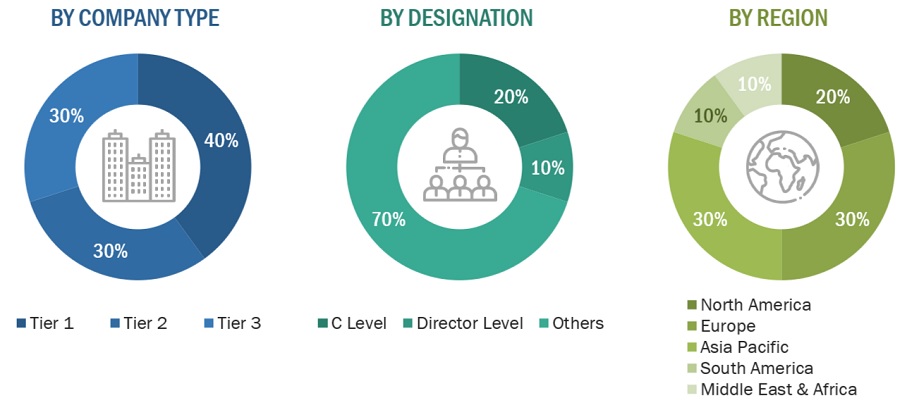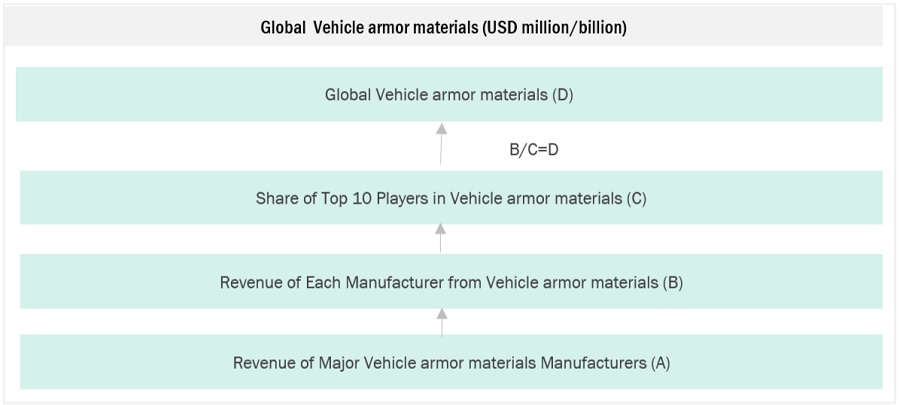The study involved four major activities in estimating the market size of the Vehicle armor materials market. Exhaustive secondary research was done to collect information on the market, the peer market, and the parent market. The next step was to validate these findings, assumptions, and sizing with industry experts across the value chain through primary research. Both top-down and bottom-up approaches were employed to estimate the complete market size. Thereafter, the market breakdown and data triangulation procedures were used to estimate the market size of the segments and subsegments.
Secondary Research
In the secondary research process, various secondary sources have been referred to for identifying and collecting information for this study. These secondary sources include annual reports, press releases, investor presentations of companies, white papers, certified publications, trade directories, articles from recognized authors, the gold standard and silver standard websites, and databases.
Secondary research has been used to obtain key information about the value chain of the industry, the monetary chain of the market, the total pool of key players, market classification, and segmentation according to industry trends to the bottom-most level and regional markets. It was also used to obtain information about the key developments from a market-oriented perspective.
Primary Research
The vehicle armor materials market comprises several stakeholders in the value chain, which include raw material suppliers, research & development, fabricators/applicators, distribution and logistics, and end users. Various primary sources from the supply and demand sides of the vehicle armor materials market have been interviewed to obtain qualitative and quantitative information. The primary interviewees from the demand side include key opinion leaders in end-use sectors. The primary sources from the supply side include manufacturers, associations, and institutions involved in the vehicle armor materials industry.
Primary interviews were conducted to gather insights such as market statistics, data on revenue collected from the products and services, market breakdowns, market size estimations, market forecasting, and data triangulation. Primary research also helped in understanding the various trends related to form, type, application, end-use industry and region. Stakeholders from the demand side, such as CIOs, CTOs, and CSOs, were interviewed to understand the buyer’s perspective on the suppliers, products, fabricators, and their current usage of vehicle armor materials and the outlook of their business, which will affect the overall market.
The breakdown of profiles of the primary interviewees is illustrated in the figure below:

Note: Tier 1, Tier 2, and Tier 3 companies are classified based on their market revenue in 2022, available in the public domain, product portfolios, and geographical presence.
Other designations include consultants and sales, marketing, and procurement managers.
To know about the assumptions considered for the study, download the pdf brochure
|
Company name
|
Designation
|
|
DuPont de Nemours, Inc.(US)
|
Individual Industry Expert
|
|
Teijin Limited (Japan)
|
Sales Manager
|
|
Morgan Advanced Materials (UK)
|
Manager
|
|
Tata Steels Limited (India)
|
Marketing Manager
|
|
Honeywell International, Inc. (US)
|
Senior Scientist
|
Market Size Estimation
The top-down and bottom-up approaches have been used to estimate and validate the size of the Vehicle armor materials market.
-
The key players in the industry have been identified through extensive secondary research.
-
The industry's supply chain has been determined through primary and secondary research.
-
All percentage shares, splits, and breakdowns have been determined using secondary sources and verified through primary sources.
-
All possible parameters that affect the markets covered in this research study have been accounted for, viewed in extensive detail, verified through primary research, and analyzed to obtain the final quantitative and qualitative data.
-
The research includes the study of reports, reviews, and newsletters of the key market players, along with extensive interviews for opinions with leaders such as directors and marketing executives.
Vehicle Armor Materials Market: Bottum-Up Approach

Note: All the shares are based on the global market size.
Source: Secondary Research, Interviews with Experts, and MarketsandMarkets Analysis
To know about the assumptions considered for the study, Request for Free Sample Report
Vehicle Armor Materials Market: Top-Down Approach

Data Triangulation
After arriving at the total market size from the estimation process explained above, the overall market has been split into several segments and sub-segments. To complete the overall market engineering process and arrive at the exact statistics for all the segments and sub-segments, the data triangulation and market breakdown procedures have been employed, wherever applicable. The data has been triangulated by studying various factors and trends from both the demand and supply sides. Along with this, the market size has been validated by using both the top-down and bottom-up approaches and primary interviews. Hence, for every data segment, there have been three sources—top-down approach, bottom-up approach, and expert interviews. The data was assumed correct when the values arrived from the three sources matched.
Market Definition
The vehicle armor materials market is defined by its focus on developing materials and technologies aimed at enhancing the protection of vehicles against various forms of attack, including ballistic threats and explosions. This market is crucial for ensuring the safety of military personnel, law enforcement officers, and civilians in high-risk environments. Central to this market is the concept of ballistic resistance, the ability of armor materials to absorb, disperse, and prevent the penetration of projectiles, thereby safeguarding the vehicle's occupants. A notable innovation within this space is composite armor, which combines materials like ceramics, polymers, and metals to exploit each material's protective properties while minimizing weight. Ceramic armor, known for its hardness and lightweight properties, exemplifies the market's trend toward materials that offer significant protective benefits without compromising vehicle performance. Additionally, the use of metal alloys, such as steel, aluminum, and titanium, provides tailored solutions that balance protection with weight considerations.
Key Stakeholders
-
Vehicle armor materials manufacturers
-
Vehicle armor materials traders, distributors, and suppliers
-
End-use industry participants of different segments of the vehicle armor materials market
-
Government and research organizations
-
Associations and industrial bodies
-
Research and consulting firms.
-
Research & development (R&D) institutions.
-
Environmental support agencies.
Report Objectives
-
To define, describe, and forecast the size of the vehicle armor materials market, in terms of value and volume.
-
To provide detailed information regarding the major factors (drivers, opportunities, restraints, and challenges) influencing the growth of the market
-
To estimate and forecast the market size based on form, type, application, end-use industry and region.
-
To forecast the size of the market with respect to major regions, namely, Europe, North America, Asia Pacific, Middle East & Africa, and South America, along with their key countries.
-
To strategically analyze micromarkets1 with respect to individual growth trends, prospects, and their contribution to the overall market.
-
To analyze opportunities in the market for stakeholders and provide a competitive landscape of market leaders.
-
To track and analyze recent developments such as expansions, new product launches, partnerships & agreements, and acquisitions in the market.
-
To strategically profile key market players and comprehensively analyze their core competencies.
Available Customizations
Along with the given market data, MarketsandMarkets offers customizations according to the company’s specific needs. The following customization options are available for the report:
Regional Analysis
-
Further breakdown of a region with respect to a particular country or additional application
Company Information
-
Detailed analysis and profiles of additional market players



Growth opportunities and latent adjacency in Vehicle Armor Materials Market